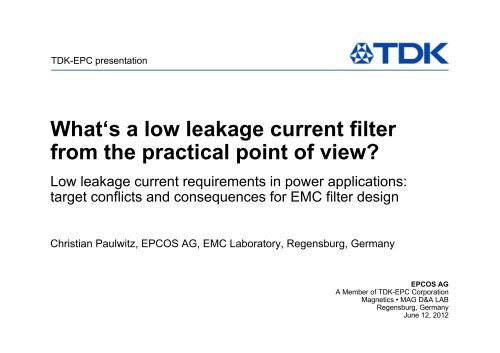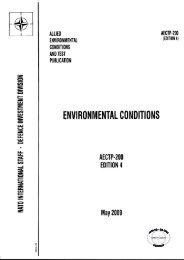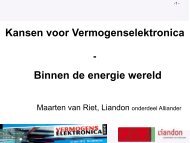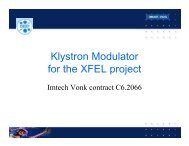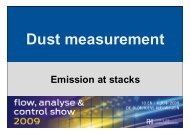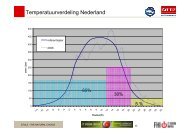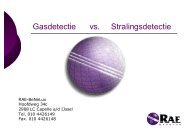What's a low leakage current filter from the practical point of view?
What's a low leakage current filter from the practical point of view?
What's a low leakage current filter from the practical point of view?
Create successful ePaper yourself
Turn your PDF publications into a flip-book with our unique Google optimized e-Paper software.
TDK-EPC presentation<br />
What‘s a <strong>low</strong> <strong>leakage</strong> <strong>current</strong> <strong>filter</strong><br />
<strong>from</strong> <strong>the</strong> <strong>practical</strong> <strong>point</strong> <strong>of</strong> <strong>view</strong>?<br />
Low <strong>leakage</strong> <strong>current</strong> requirements in power applications:<br />
target conflicts and consequences for EMC <strong>filter</strong> design<br />
Christian Paulwitz, EPCOS AG, EMC Laboratory, Regensburg, Germany<br />
EPCOS AG<br />
A Member <strong>of</strong> TDK-EPC Corporation<br />
Magnetics • MAG D&A LAB<br />
Regensburg, Germany<br />
June 12, 2012
TDK-EPC presentation<br />
Who is TDK-EPC?<br />
Short Company Presentation<br />
What‘s a <strong>low</strong> <strong>leakage</strong> <strong>current</strong> <strong>filter</strong> <strong>from</strong> <strong>the</strong> <strong>practical</strong> <strong>point</strong> <strong>of</strong> <strong>view</strong>? • Target conflicts and consequences<br />
© TDK-EPC 2012<br />
MAG D&A LAB • 06/12 • 2
TDK-EPC presentation<br />
TDK-EPC. Global excellence in electronic<br />
components, modules and systems<br />
SAE<br />
Recording Heads<br />
for HDD<br />
Electronic<br />
Components<br />
TDK-Lambda<br />
Power Supplies<br />
O<strong>the</strong>r<br />
TDK businesses<br />
ATL<br />
Batteries<br />
TDK-EPC<br />
What‘s a <strong>low</strong> <strong>leakage</strong> <strong>current</strong> <strong>filter</strong> <strong>from</strong> <strong>the</strong> <strong>practical</strong> <strong>point</strong> <strong>of</strong> <strong>view</strong>? • Target conflicts and consequences<br />
© TDK-EPC 2012<br />
MAG D&A LAB • 06/12 • 3
TDK-EPC presentation<br />
TDK-EPC at a glance<br />
TDK-EPC has emerged <strong>from</strong> <strong>the</strong> combination <strong>of</strong> EPCOS and <strong>the</strong> electronic components<br />
business <strong>of</strong> TDK and markets its products under <strong>the</strong> product brands, TDK and EPCOS.<br />
Key info (Fiscal Year 2012, ending March 31)<br />
Evolution<br />
Core business<br />
Headquarters<br />
Electronic components,<br />
modules and systems<br />
Tokyo, Japan<br />
Munich, Germany<br />
1935<br />
TDK (Tokyo Denki Kagaku Kogyo =<br />
Tokyo Electric and Chemical<br />
Industries) established in Japan<br />
to manufacture and commercialize<br />
ferrites<br />
Sales<br />
Number <strong>of</strong><br />
sites<br />
Employees<br />
total<br />
EUR 3.5 billion<br />
approx. 40,<br />
more than 50 plants<br />
43,000<br />
1999<br />
2009<br />
Oct. 1<br />
EPCOS founded in Germany,<br />
emerging <strong>from</strong> Siemens Matsushita<br />
Components, a joint venture <strong>of</strong><br />
Siemens Passive Components with<br />
Matsushita<br />
TDK-EPC Corporation established<br />
in Japan<br />
What‘s a <strong>low</strong> <strong>leakage</strong> <strong>current</strong> <strong>filter</strong> <strong>from</strong> <strong>the</strong> <strong>practical</strong> <strong>point</strong> <strong>of</strong> <strong>view</strong>? • Target conflicts and consequences<br />
© TDK-EPC 2012<br />
MAG D&A LAB • 06/12 • 4
TDK-EPC presentation<br />
Broad portfolio <strong>of</strong> TDK and EPCOS solutions<br />
• Multilayer Ceramic<br />
Capacitors<br />
• Aluminum Electrolytic<br />
Capacitors<br />
• Film Capacitors<br />
• Ferrites<br />
• Inductors<br />
• Transformers<br />
• EMC Components<br />
• SAW and BAW Filter Products<br />
• Radio-Frequency Modules<br />
• ESD/EMI Modules<br />
• MEMS Products<br />
• Multilayer High-Frequency<br />
Components<br />
• Microwave Ceramic<br />
Components<br />
• Piezo<br />
Devices<br />
• Thermistors<br />
• Varistors<br />
• Surge<br />
Arresters<br />
• Sensors<br />
What‘s a <strong>low</strong> <strong>leakage</strong> <strong>current</strong> <strong>filter</strong> <strong>from</strong> <strong>the</strong> <strong>practical</strong> <strong>point</strong> <strong>of</strong> <strong>view</strong>? • Target conflicts and consequences<br />
© EPCOS TDK-EPC AG 2012<br />
A Member MAG <strong>of</strong> TDK-EPC D&A LAB Corporation<br />
• 06/12 • 5<br />
CC 04/12 • 05
TDK-EPC presentation<br />
Pr<strong>of</strong>essional High-End EMC Filters<br />
Over<strong>view</strong> standard <strong>filter</strong>s<br />
1-line <strong>filter</strong>s<br />
Feedthrough components, up to 500 A<br />
2-line <strong>filter</strong>s<br />
19 series, 164 types, up to 1000 A<br />
3-line <strong>filter</strong>s<br />
12 series, 80 types, up to 2500 A<br />
4-line <strong>filter</strong>s<br />
7 series, 38 types, up to 1600 A<br />
Filters for shielded rooms<br />
What‘s a <strong>low</strong> <strong>leakage</strong> <strong>current</strong> <strong>filter</strong> <strong>from</strong> <strong>the</strong> <strong>practical</strong> <strong>point</strong> <strong>of</strong> <strong>view</strong>? • Target conflicts and consequences<br />
© TDK-EPC 2012<br />
MAG D&A LAB • 06/12 • 6
TDK-EPC presentation<br />
Complete Solution Provider for Drive Applications<br />
Line reactors / PFC<br />
chokes<br />
Main<br />
Rectifier<br />
DC link<br />
Inverter<br />
Dv/dt choke<br />
Sine-wave<br />
<strong>filter</strong><br />
Motor<br />
M<br />
Ongoing portfolio extension<br />
Existing portfolio<br />
EMC <strong>filter</strong>s<br />
Standard and<br />
custom specific<br />
SineFormer TM<br />
Reduces<br />
common-mode<br />
disturbances<br />
What‘s a <strong>low</strong> <strong>leakage</strong> <strong>current</strong> <strong>filter</strong> <strong>from</strong> <strong>the</strong> <strong>practical</strong> <strong>point</strong> <strong>of</strong> <strong>view</strong>? • Target conflicts and consequences<br />
© TDK-EPC 2012<br />
MAG D&A LAB • 06/12 • 7
TDK-EPC presentation<br />
What‘s a <strong>low</strong> <strong>leakage</strong> <strong>current</strong> <strong>filter</strong><br />
<strong>from</strong> <strong>the</strong> <strong>practical</strong> <strong>point</strong> <strong>of</strong> <strong>view</strong>?<br />
Low <strong>leakage</strong> <strong>current</strong> requirements in power applications:<br />
target conflicts and consequences for EMC <strong>filter</strong> design<br />
What‘s a <strong>low</strong> <strong>leakage</strong> <strong>current</strong> <strong>filter</strong> <strong>from</strong> <strong>the</strong> <strong>practical</strong> <strong>point</strong> <strong>of</strong> <strong>view</strong>? • Target conflicts and consequences<br />
© TDK-EPC 2012<br />
MAG D&A LAB • 06/12 • 8
TDK-EPC presentation<br />
Presentation Structure<br />
• Leakage <strong>current</strong>: What do we talk about?<br />
• Origins <strong>of</strong> Leakage Current<br />
• Consequences for EMC <strong>filter</strong>ing<br />
• Suitability <strong>of</strong> different measurement procedures<br />
• Summary<br />
What‘s a <strong>low</strong> <strong>leakage</strong> <strong>current</strong> <strong>filter</strong> <strong>from</strong> <strong>the</strong> <strong>practical</strong> <strong>point</strong> <strong>of</strong> <strong>view</strong>? • Target conflicts and consequences<br />
© TDK-EPC 2012<br />
MAG D&A LAB • 06/12 • 9
TDK-EPC presentation<br />
Leakage Current: What do we talk about?<br />
International Electrotechnical Vocabulary:<br />
“electric <strong>current</strong> in an unwanted conductive path<br />
under normal operating conditions”<br />
Examples for different settings:<br />
‣ possible direct <strong>current</strong> through a human body (touch <strong>current</strong>),<br />
‣ ensure correct function <strong>of</strong> protective devices during normal operation<br />
conditions (residual <strong>current</strong>),<br />
‣ Leakage <strong>current</strong>s reducing installation life time (z. B. bearing <strong>current</strong>s in<br />
converter-driven motors),<br />
‣ High <strong>leakage</strong> <strong>current</strong>s in unbalanced and harmonic-containing systems<br />
(e. g. PEN installations).<br />
What‘s a <strong>low</strong> <strong>leakage</strong> <strong>current</strong> <strong>filter</strong> <strong>from</strong> <strong>the</strong> <strong>practical</strong> <strong>point</strong> <strong>of</strong> <strong>view</strong>? • Target conflicts and consequences<br />
© TDK-EPC 2012<br />
MAG D&A LAB • 06/12 • 10
TDK-EPC presentation<br />
Leakage Current: What do we talk about?<br />
Physiological effects <strong>of</strong> <strong>the</strong> electric <strong>current</strong>:<br />
Duration <strong>of</strong> <strong>current</strong> f<strong>low</strong> t<br />
Zones:<br />
AC-1 – Imperceptible<br />
AC-2 – Perceptible<br />
AC-3 – Reversible<br />
effects: muscular<br />
contraction<br />
AC-4 – Possibility <strong>of</strong><br />
irreversible<br />
effects.<br />
Probability <strong>of</strong> heart<br />
fibrillation:<br />
AC-4-1: up to 5 %<br />
AC-4-2: up to 50 %<br />
AC-4-3 >50 %<br />
Current through <strong>the</strong> body I B<br />
Source: IEC/TS 60479-1 (2005)<br />
What‘s a <strong>low</strong> <strong>leakage</strong> <strong>current</strong> <strong>filter</strong> <strong>from</strong> <strong>the</strong> <strong>practical</strong> <strong>point</strong> <strong>of</strong> <strong>view</strong>? • Target conflicts and consequences<br />
© TDK-EPC 2012<br />
MAG D&A LAB • 06/12 • 11
TDK-EPC presentation<br />
Leakage Current: What do we talk about?<br />
Thresholds <strong>of</strong> protective devices – like RCD – correspond to <strong>the</strong> areas <strong>of</strong><br />
physiological effects on a human body.<br />
Note:<br />
RCD device “30 mA” → tripping threshold approx. 15 mA<br />
RCD device “300 mA” → tripping threshold approx. 150 mA<br />
What‘s a <strong>low</strong> <strong>leakage</strong> <strong>current</strong> <strong>filter</strong> <strong>from</strong> <strong>the</strong> <strong>practical</strong> <strong>point</strong> <strong>of</strong> <strong>view</strong>? • Target conflicts and consequences<br />
© TDK-EPC 2012<br />
MAG D&A LAB • 06/12 • 12
TDK-EPC presentation<br />
Leakage Current: What do we talk about?<br />
Typical touch <strong>current</strong> requirements (maximum <strong>current</strong> which may f<strong>low</strong><br />
through a human body) for devices :<br />
3.5 mA (example: for plugable devices, if it is touched while<br />
<strong>the</strong> PE conductor might be broken)<br />
0.5 mA (example: protective class II, medical devices)<br />
What‘s a <strong>low</strong> <strong>leakage</strong> <strong>current</strong> <strong>filter</strong> <strong>from</strong> <strong>the</strong> <strong>practical</strong> <strong>point</strong> <strong>of</strong> <strong>view</strong>? • Target conflicts and consequences<br />
© TDK-EPC 2012<br />
MAG D&A LAB • 06/12 • 13
TDK-EPC presentation<br />
Origins <strong>of</strong> Leakage Current<br />
What is a <strong>low</strong>-<strong>leakage</strong> <strong>current</strong> <strong>filter</strong>?<br />
‣ … all EMC <strong>filter</strong>s – as long as no voltage will be applied!<br />
That means: Leakage <strong>current</strong> depends not only on <strong>filter</strong> components,<br />
but<br />
‣ … on <strong>the</strong> power supply voltage (amplitude, frequency, phase balance,<br />
harmonics content);<br />
‣ … on <strong>the</strong> internal voltage sources <strong>of</strong> <strong>the</strong> application:<br />
to be found at switch-mode PWM voltages!<br />
What‘s a <strong>low</strong> <strong>leakage</strong> <strong>current</strong> <strong>filter</strong> <strong>from</strong> <strong>the</strong> <strong>practical</strong> <strong>point</strong> <strong>of</strong> <strong>view</strong>? • Target conflicts and consequences<br />
© TDK-EPC 2012<br />
MAG D&A LAB • 06/12 • 14
TDK-EPC presentation<br />
Origins <strong>of</strong> Leakage Current<br />
Sources, responsible for causing <strong>leakage</strong> <strong>current</strong>:<br />
supply voltage<br />
EMC <strong>filter</strong> power electronic application<br />
mains cable with parasitic<br />
properties<br />
<strong>leakage</strong> <strong>current</strong> parts, caused<br />
by supply voltage<br />
<strong>leakage</strong> <strong>current</strong> parts, caused by voltages<br />
application-internally generated<br />
What‘s a <strong>low</strong> <strong>leakage</strong> <strong>current</strong> <strong>filter</strong> <strong>from</strong> <strong>the</strong> <strong>practical</strong> <strong>point</strong> <strong>of</strong> <strong>view</strong>? • Target conflicts and consequences<br />
© TDK-EPC 2012<br />
MAG D&A LAB • 06/12 • 15
TDK-EPC presentation<br />
Origins <strong>of</strong> Leakage Current<br />
Sources, responsible for causing <strong>leakage</strong> <strong>current</strong>:<br />
supply voltage<br />
EMC <strong>filter</strong><br />
power electronic application<br />
f mains : n x 50 Hz<br />
f pulse : 2…16 kHz<br />
Z L : ~ 0 Typical location<br />
for residual <strong>current</strong><br />
Z C : large measurements<br />
(<strong>the</strong> smaller C <strong>the</strong> smaller I leak )<br />
Z L : according to L: ra<strong>the</strong>r large<br />
Z C : according to C: ra<strong>the</strong>r small<br />
(<strong>the</strong> larger C <strong>the</strong> smaller I leak )<br />
Note also: <strong>leakage</strong> <strong>current</strong> raises at f pulse ~ resonance frequency <strong>of</strong> L and C<br />
What‘s a <strong>low</strong> <strong>leakage</strong> <strong>current</strong> <strong>filter</strong> <strong>from</strong> <strong>the</strong> <strong>practical</strong> <strong>point</strong> <strong>of</strong> <strong>view</strong>? • Target conflicts and consequences<br />
© TDK-EPC 2012<br />
MAG D&A LAB • 06/12 • 16
TDK-EPC presentation<br />
Suitability <strong>of</strong> Different Measurement Procedures<br />
What are <strong>the</strong> specific requirements? – Examples:<br />
1) Limitation <strong>of</strong> <strong>the</strong> maximum touch <strong>current</strong><br />
(typical requirements for devices with plugs)?<br />
2) RCD compatibility<br />
(in most cases more important requirement at fixed installed<br />
applications)?<br />
Attention:<br />
• One <strong>of</strong> <strong>the</strong> requirements does not automatically cover <strong>the</strong> o<strong>the</strong>r one!<br />
• Definition <strong>of</strong> operating modes!<br />
• Definition <strong>of</strong> setup conditions, which might be relevant for <strong>leakage</strong><br />
<strong>current</strong>s!<br />
What‘s a <strong>low</strong> <strong>leakage</strong> <strong>current</strong> <strong>filter</strong> <strong>from</strong> <strong>the</strong> <strong>practical</strong> <strong>point</strong> <strong>of</strong> <strong>view</strong>? • Target conflicts and consequences<br />
© TDK-EPC 2012<br />
MAG D&A LAB • 06/12 • 17
TDK-EPC presentation<br />
Suitability <strong>of</strong> Different Measurement Procedures<br />
Touch <strong>current</strong>, e. g. according to IEC/EN 60990 (figure 4), weighting with<br />
regard to perception/reaction:<br />
100.0%<br />
A<br />
B<br />
1,5 kΩ<br />
test<br />
terminal<br />
500 Ω<br />
220 nF<br />
20 kΩ<br />
Bewertung weighting<br />
U 1 U 2<br />
22 nF<br />
90.0%<br />
80.0%<br />
70.0%<br />
60.0%<br />
50.0%<br />
40.0%<br />
30.0%<br />
20.0%<br />
10.0%<br />
Weighted touch <strong>current</strong><br />
(perception and reaction):<br />
U 2<br />
500 Ω<br />
0.0%<br />
10 100 1000 10000 100000<br />
Frequenz [Hz]<br />
peak value!<br />
frequency (Hz)<br />
Example: sinusoidal <strong>current</strong> <strong>of</strong> 1 mA / frequency f; measured with perception/reaction network:<br />
f = 50 Hz => <strong>current</strong> assessment as „1 mA“ (100 %)<br />
f = 1 kHz => <strong>current</strong> assessment as „0,57 mA“ (57 %)<br />
f = 5 kHz => <strong>current</strong> assessment as „0,13 mA“ (13 %)<br />
What‘s a <strong>low</strong> <strong>leakage</strong> <strong>current</strong> <strong>filter</strong> <strong>from</strong> <strong>the</strong> <strong>practical</strong> <strong>point</strong> <strong>of</strong> <strong>view</strong>? • Target conflicts and consequences<br />
© TDK-EPC 2012<br />
MAG D&A LAB • 06/12 • 18
TDK-EPC presentation<br />
Suitability <strong>of</strong> Different Measurement Procedures<br />
An RCD shows quite a similar weighting curve up to <strong>the</strong> kHz range …<br />
weighting<br />
Bewertung gegenüber tatsächlichem Strom<br />
120%<br />
100%<br />
80%<br />
60%<br />
40%<br />
20%<br />
0%<br />
10 100 1000 10000 100000<br />
Frequenz (Hz)<br />
frequenzy (Hz)<br />
Abweichung frequencyMessung weighting über curve FI-Nachbildung artificial RCD<br />
Measured characteristic <strong>of</strong> an artificial RCD with measurement output<br />
instead <strong>of</strong> tripping circuit (Siemens 5SM1 930-0)<br />
What‘s a <strong>low</strong> <strong>leakage</strong> <strong>current</strong> <strong>filter</strong> <strong>from</strong> <strong>the</strong> <strong>practical</strong> <strong>point</strong> <strong>of</strong> <strong>view</strong>? • Target conflicts and consequences<br />
© TDK-EPC 2012<br />
MAG D&A LAB • 06/12 • 19
TDK-EPC presentation<br />
Suitability <strong>of</strong> Different Measurement Procedures<br />
RCD standardisation for <strong>the</strong> kHz range; DIN V VDE V 0664-210;<br />
RCBO (residual <strong>current</strong> operated circuit-breaker with over<strong>current</strong> protection) type B+<br />
(defined e. g. for DC/AC residual <strong>current</strong>s up to 20 kHz, pulsed DC residual <strong>current</strong>s)<br />
tripping <strong>current</strong> ranges for RCBO type B+ for frequencies up to 20 kHz<br />
frequency<br />
tripping <strong>current</strong><br />
<strong>low</strong>er limit<br />
tripping <strong>current</strong> upper limit<br />
I Δn : standard value <strong>of</strong> rated residual <strong>current</strong><br />
What‘s a <strong>low</strong> <strong>leakage</strong> <strong>current</strong> <strong>filter</strong> <strong>from</strong> <strong>the</strong> <strong>practical</strong> <strong>point</strong> <strong>of</strong> <strong>view</strong>? • Target conflicts and consequences<br />
© TDK-EPC 2012<br />
MAG D&A LAB • 06/12 • 20
TDK-EPC presentation<br />
Suitability <strong>of</strong> Different Measurement Procedures<br />
… but in <strong>the</strong> kHz range <strong>the</strong> different impedances <strong>of</strong> <strong>the</strong> measurement<br />
apparatus have an influence on <strong>the</strong> <strong>leakage</strong> <strong>current</strong>!<br />
supply voltage<br />
Z i small<br />
L1…L3, N<br />
PE<br />
EMC <strong>filter</strong><br />
example:<br />
L = 1 mH<br />
example:<br />
C = 10 nF<br />
power electronic application<br />
position RCD<br />
within installation<br />
Z -> 0<br />
position measurement<br />
network for touch <strong>current</strong><br />
50 Hz: Z -> 2 kΩ<br />
5 kHz: Z -> 600 Ω<br />
Example with figures for L = 1 mH and C = 22 nF:<br />
50 Hz: Z(L) -> 0,3 Ω Z(C) -> 300 kΩ<br />
5 kHz: Z(L) -> 30 Ω Z(C) -> 3 kΩ<br />
What‘s a <strong>low</strong> <strong>leakage</strong> <strong>current</strong> <strong>filter</strong> <strong>from</strong> <strong>the</strong> <strong>practical</strong> <strong>point</strong> <strong>of</strong> <strong>view</strong>? • Target conflicts and consequences<br />
© TDK-EPC 2012<br />
MAG D&A LAB • 06/12 • 21
TDK-EPC presentation<br />
Suitability <strong>of</strong> Different Measurement Procedures<br />
Example: two frequency converter setups (single phase / 3 phase, ca. 3 kW),<br />
5 m motor cable, different switching frequencies<br />
operation<br />
mode<br />
Standby<br />
2 kHz / 50 Hz<br />
2 kHz / 0.5 Hz<br />
5 kHz / 50 Hz<br />
5 kHz / 0.5 Hz<br />
8 kHz / 50 Hz<br />
8 kHz / 0.5 Hz<br />
10 kHz / 50 Hz<br />
10 kHz / 0.5 Hz<br />
15 kHz / 50 Hz<br />
15 kHz / 0.5 Hz<br />
single phase system<br />
residual<br />
<strong>current</strong><br />
3.1 mA<br />
3.5 mA<br />
5.3 mA<br />
3.9 mA<br />
5.7 mA<br />
3.7 mA<br />
11.3 mA<br />
3.5 mA<br />
15.4 mA<br />
3.6 mA<br />
4.1 mA<br />
touch<br />
<strong>current</strong><br />
2.6 mA<br />
2.7 mA<br />
3.5 mA<br />
2.7 mA<br />
3.6 mA<br />
2.7 mA<br />
3.8 mA<br />
2.7 mA<br />
3.7 mA<br />
2.7 mA<br />
2.9 mA<br />
3 phase system<br />
residual touch<br />
<strong>current</strong> <strong>current</strong><br />
1.3 mA 1.5 mA<br />
8.8 mA 2.0 mA<br />
12.8 mA 4.0 mA<br />
7.4 mA 1.7 mA<br />
25.5 mA 3.7 mA<br />
4.4 mA 1.7 mA<br />
12.0 mA 3.0 mA<br />
4.2 mA 1.6 mA<br />
7.2 mA 2.5 mA<br />
4.3 mA 1.6 mA<br />
5.0 mA 1.9 mA<br />
Comparison: touch <strong>current</strong> measurement vs. residual-<strong>current</strong>-operated protection device<br />
Validation: Does <strong>the</strong> RCD not trip,<br />
if <strong>the</strong> touch <strong>current</strong> requirement <strong>of</strong> 3.5 mA is met?<br />
What‘s a <strong>low</strong> <strong>leakage</strong> <strong>current</strong> <strong>filter</strong> <strong>from</strong> <strong>the</strong> <strong>practical</strong> <strong>point</strong> <strong>of</strong> <strong>view</strong>? • Target conflicts and consequences<br />
© TDK-EPC 2012<br />
MAG D&A LAB • 06/12 • 22
TDK-EPC presentation<br />
Suitability <strong>of</strong> Different Measurement Procedures<br />
Example: two frequency converter setups (single phase / 3 phase, ca. 3 kW),<br />
5 m motor cable, different switching frequencies<br />
Comparison: touch <strong>current</strong> measurement vs. RCD<br />
5<br />
4.5<br />
4<br />
Berührstrom touch <strong>current</strong> [mA]<br />
3.5<br />
3<br />
2.5<br />
2<br />
1.5<br />
1<br />
0.5<br />
0<br />
0 5 10 15 20 25 30<br />
residual Fehlerstrom <strong>current</strong> [mA]<br />
Standby 2 kHz 5 kHz 8 kHz 10 kHz 15 kHz<br />
What‘s a <strong>low</strong> <strong>leakage</strong> <strong>current</strong> <strong>filter</strong> <strong>from</strong> <strong>the</strong> <strong>practical</strong> <strong>point</strong> <strong>of</strong> <strong>view</strong>? • Target conflicts and consequences<br />
© TDK-EPC 2012<br />
MAG D&A LAB • 06/12 • 23
TDK-EPC presentation<br />
Summary<br />
• Specification <strong>of</strong> <strong>leakage</strong> <strong>current</strong> requirements:<br />
- definition <strong>of</strong> targets<br />
- choice <strong>of</strong> <strong>the</strong> suitable measurement procedure; maybe more than one<br />
might be necessary.<br />
• Initiators <strong>of</strong> <strong>leakage</strong> <strong>current</strong>s:<br />
- power supply <strong>of</strong> <strong>the</strong> application (power frequency)<br />
- switch-mode voltages generated by <strong>the</strong> application (usually kHz range)<br />
Filter components do not cause <strong>leakage</strong> <strong>current</strong>s but influence <strong>the</strong>m<br />
depending on <strong>the</strong> initiator.<br />
• Matching EMC <strong>filter</strong>s to <strong>leakage</strong> <strong>current</strong> requirements::<br />
- power supply voltage limits capacitance to ground<br />
- higher frequency parts <strong>of</strong> <strong>the</strong> <strong>leakage</strong> <strong>current</strong> require <strong>the</strong>n<br />
big <strong>filter</strong> inductances<br />
- considering <strong>filter</strong> resonances => inductances might have to get even bigger<br />
=> The more restrictive <strong>the</strong> requirements, <strong>the</strong> bigger and <strong>the</strong> more expensive <strong>the</strong><br />
<strong>filter</strong>.<br />
What‘s a <strong>low</strong> <strong>leakage</strong> <strong>current</strong> <strong>filter</strong> <strong>from</strong> <strong>the</strong> <strong>practical</strong> <strong>point</strong> <strong>of</strong> <strong>view</strong>? • Target conflicts and consequences<br />
© TDK-EPC 2012<br />
MAG D&A LAB • 06/12 • 24
TDK-EPC presentation<br />
Contact<br />
Christian Paulwitz<br />
EPCOS AG<br />
A Member <strong>of</strong> TDK-EPC Corporation<br />
EMC Laboratory<br />
Wernerwerkstraße 2<br />
D-93049 Regensburg<br />
Germany<br />
Telephone: +49 941 850 6107<br />
Fax: +49 941 850 6110<br />
christian.paulwitz@epcos.com<br />
www.global.tdk.com · www.epcos.com<br />
Bart van den Broek<br />
BMF System Parts BV<br />
Gulberg 43 A<br />
5674 TE Nuenen<br />
The Ne<strong>the</strong>rlands<br />
Telephone: +31(0)40-8512170<br />
Fax: +31(0)40-8512171<br />
info@bmf-systemparts.com<br />
www.bmf-systemparts.com<br />
What‘s a <strong>low</strong> <strong>leakage</strong> <strong>current</strong> <strong>filter</strong> <strong>from</strong> <strong>the</strong> <strong>practical</strong> <strong>point</strong> <strong>of</strong> <strong>view</strong>? • Target conflicts and consequences<br />
© TDK-EPC 2012<br />
MAG D&A LAB • 06/12 • 25
TDK-EPC presentation<br />
www.tdk-epc.com


